Ethnobotanical
Portraits
Backgrounds
All the backgrounds for
this issue of the Handbook are drawn from
ethnobotanical collections made in the
souk, or traditional marketplace, of
Marrakech, Morocco. These baskets, fruits
and cosmetic herbs are important in North
African culture. / GJM
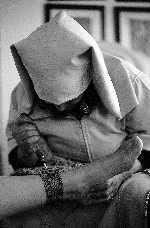 |
| Moroccan
woman creating an anklet
design with henna paste
in Marrakech |
|
Leaves,
sold whole or pounded into
powder, come from the henna
plant, Lawsonia inermis L.
(Lythraceae), which is reputed to
be a native of southern Iran but
is commonly cultivated in North
Africa an/ many other
Arabic-Islamic regions. The
powdered leaves, mixed with a
variety of fixatives, are used to
create intricate skin decorations
in many countries, from India to
Mauritania. In Morocco, henna is
used to treat a range of skin
conditions, from burns to eczema.
Aline Tauzin, a French
ethnologist, has written an
exceptionally beautiful book in
French on the use of henna in
Mauritania, titled Le Henné,
Art des Femmes de
Mauritanie.This volume is
the first in a collection of
small illustrated books on
women’s traditional arts and
crafts co-published by Ibis Press
and UNESCO. |
CONTACT
Bernard
Cesari, Ibis Press, 8 rue des Lyonnais
75005 Paris, France;|
Tel. +33.1.47072114,Fax +33.1.47075222,
E-mail ibispres@francenet.fr
| Textures, from a basket made
with leaf fibers of the dwarf fan
palm, Chamaerops humilis
L. (Arecaceae), which is one of
only two palms native to Europe
(the other is Phoenix
theophrasti Greuter, the
Cretan palm, an endangered
species related to the date
palm). Chamaerops humilis,
which is found from the Iberian
Peninsula and North Africa
eastwards to Italy and Malta, has
multiple uses. Apart from being
woven into baskets, the leaf
fibers are made into mats, brooms
and rope. The young buds are
eaten as a vegetable, and the
whole plant is cultivated as an
ornamental throughout the
Mediterranean. Its stature is an
indicator of human use. |
 |
| A tradtional
carrying basket, typical
of the Mediterranean
region and North Africa,
made from dwarf fan palm
fibers |
|
Though capable of producing trunks up
to 4m, the palm is often stunted because
of overharvesting and grazing. Teresa
Almeida, a Portuguese ethnobotanist, is
developing a project to promote
cultivation of the dwarf fan palm, and
recovery of traditional ways of weaving
the leaf fiber.
CONTACT
Teresa Almeida,
Departamento de Botânica, Universidade
de Coimbra, Arcos do Jardim, P-3000
Coimbra, Portugal;
Tel. +35.139.822897 or 825221 or
827625,Fax +35.139.820780,
E-mail talmeida@cygnus.ci.uc.pt
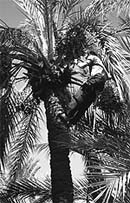 |
| Hassan
Nafari harvesting
dates in the Palmeraie of
Marrakech, Morocco |
|
| Seeds are sometimes
covered with a sweet,
edible pulp such as these
dates (Phoenix
dactylifera
L., Arecaceae)
harvested in a desert
oasis of Morocco. The
date palm is a tall
dioecious plant, reaching
up to 30 m, which is
typically propagated by
offshoots from mature
female individuals. |
 |
It requires high temperatures
and low air humidity for fruit
setting and ripening, yet
abundant ground water (from
irrigation or a high water table)
for growth. The date was
domesticated more than 6000 years
ago. It is a staple food of
nomadic people in Arabia and
North Africa. The Moors
introduced dates into Spain, and
subsequently the Spanish brought
the fruit to the Americas.
|
You can find more information on dates
and other domesticated plants on a
Website created by Paul Gepts of the
University of California at Davis for his
course on evolution of crop plants,
Website http://agronomy.ucdavis.edu/GEPTS/pb143/pb143.htm.
The University of California Fruit and
Nut Research and Information Center
offers information on dates and many
other crops.
CONTACT
UC
Fruit & Nut Research and Information
Center,
Department of Pomology, University of
California, One Shields Ave., Davis, CA
95616-8683 USA;
Tel. +1.530.7549708, Fax +1.530.7528502,
E-mail fruitsandnuts@ucdavis.edu Website http://fruitsandnuts.ucdavis.edu
BACK
Profiles
Mariliza V.
Ticsay-Ruscoe
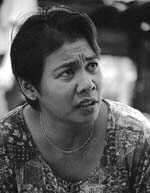 |
Mariliza Ticsay-Ruscoe is
program manager of the
Environmental Security and
Management Programme of the
Institute of Environmental
Science and Management (ESMP/
IESAM), University of Philippines
Los Baños (UPLB). She has served
as project officer and country
team leader of a biodiversity
study sponsored by the Southeast
Asian Unversities Agroecosystem
Network (SUAN). In addition to
Tagalog and English, she speaks
Kapampangan, a local language of
Luzon.She completed a
Bachelor’s of Science in
biology, a Master’s of
Science in botany and a Ph.D. in
forest ecology, all at UPLB. |
Her research has focused on how some
indigenous groups in the Philippine
uplands manage biological resources.
Together with the Chinese ethnobotanist
Xu Jianchu, she authored a booklet on The
Use of Indigneous Knowledge in
Agroecosystem Management for Biodiversity
Conservation: A Case Study in Barangay
Haliap, Kiangan, Ifugao, Central
Cordillera, Philippines, published
by UPLB and the Ford Foundation.
CONTACT
Mariliza V.
Ticsay-Ruscoe, Environmental Security and
Management Programme (ESMP), School of
Environmental Science and Management
(SESAM), University of Philippines Los
Baños (UPLP), College, Laguna, 4031
Philippines;
Tel. +63.918.2608119, Fax.
+63.94.5362251,
E-mail mvtr@mudspring.uplb.edu.ph /GJM
Liwayway
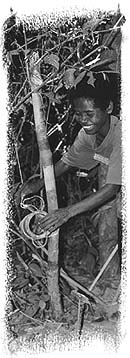 |
Liwayway, a
speaker of Ambala Aeta, was born
in 1952 in the forests of Mt.
Dingga, Bataan Province,
west-central Luzon, Philippines.
An orphan at age seven, she was
raised by her aunts, who served
as the traditional midwives and
“herbolarias”
(traditional healers) of the
village. At an early age Liwayway
began learning about plants and
their medicinal value, and she
became especially interested in
traditional remedies used during
childbirth and “binat”
or relapse. Liway, as she is
fondly called, married Alfredo
del Cosar, a non-Aeta from
Floridablanca, Pampanga. They
have four children. She and her
children moved to Pastolan
Village in Subic, Zambales in
1988 upon invitation of her older
brother.In 1990, Liway and a
group of Aetas from Pastolan
Village were recruited to work
for the Subic Bay Municipal
Authority (SBMA). After fourteen
months of volunteer services,
cleaning up and rehabilitating
what is now the Pamulaklakin
Stream Resort, Liway was
officially employed as a forest
trail guide in the SBMA.
|
Liway has assisted several students
and researchers from the University of
the Philippines at Los Baños who have
been carrying out ethnobotanical research
in the Subic forests. In addition, she
was a valuable resource person for the
quantitative methods session of the
People and Plants in Southeast Asia
Certificate Training Course in Applied
Ethnobotany, held in Subic Bay from 16
– 27 February 1998.
CONTACT
Susanah
dela Rama, Head, SBMA Tourism Department,
Tel. +63.47.2524429 or 2524123 or
2527711, Fax +63.47.2523856 or 2523857,
E-mail tourism@subic.com.ph
Attn: Liwayway, Pamulaklakin Stream
Resort, Pastolan Village. /MVTR
BACK
What
is this?
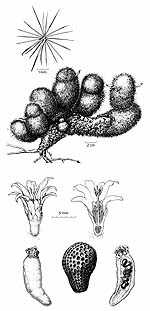 |
It is Mammilaria
estebanesis Lindsay
(Cactaceae), the San Esteban
fishhook cactus, which is endemic
to San Esteban Island in the Gulf
of California. The Seri people of
northwestern Mexico, who call the
cactus hant iipzx iteja
caacöl, eat the
orange-red fruits as a snack. The
illustration and ethnobotanical
information are from Felger, R.S.
and M.B. Moser. 1985. People of
the Desert and Sea: Ethnobotany
of the Seri Indians. Tucson,
University of Arizona Press.
Richard Felger, an expert on the
flora and economic botany of the
Sonoran Desert region, produced
this ethnobotanical monograph
with Mary Beck Moser, who began
studying the Seri language in the
1950s. Rich in line drawings and
archival photographs, the book
describes many aspects of the
Seri’s relationship with
their desert and marine
environment, including their use
of hundreds of flowering plants.
|
It is available from :-
The University of Arizona Press, 1230
N. Park Avenue, Tucson, Arizona 85719
USA; E-mail orders@uapress.arizona.edu
Website http://www.uapress.arizona.edu
BACK
|